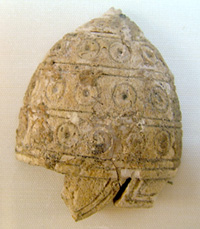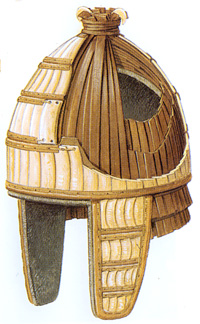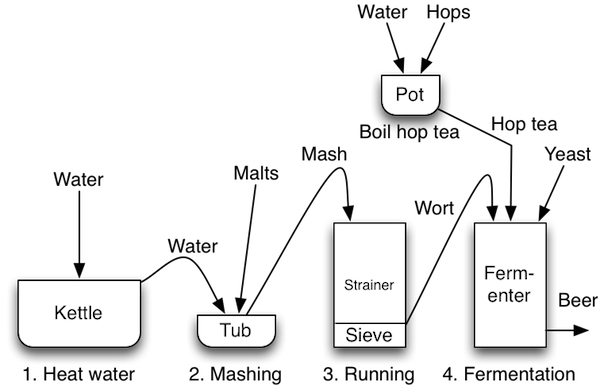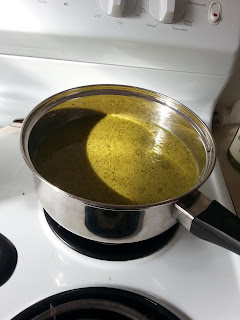I want to make a beehive helmet, like the one shown in this ivory relief from Phaistos. It's basically the same thing as the famous boars' tusk helmet featured in the Iliad, but with what appear to be metal studs instead of tusks. Metal studs may have been a cheaper alternative and were a popular choice right up until the end of the Bronze Age.
Various forms of beehive helmet are depicted in Greek art from the Neolithic through to the end of the Bronze Age, but they all have that distinctive conical shape and in most cases seem to have been made from leather or linen, although metal versions did exist (and in some cases they continued to be used in the Classical period).
I'm reluctant to compare the beehive helmet to a modern military helmet, because it was designed for a different purpose. The beehive helmet didn't have to stop bullets, because in 1600 BCE bullets didn't exist yet. It had to protect the wearer from arrows and sword blows, as well as maces and stones fired from slingshots. Slingshots were not uncommon on ancient battlefields in Europe and the Near East because they were cheap, and they could be very effective too.
This meant the beehive helmet had to be resistant to cutting or piercing, and it also had to protect the wearer from blunt force trauma. It would have been very important to use designs and materials that could absorb and dissipate the kinetic energy from an impact. In this respect I think the beehive helmet would have worked rather like a motorcycle helmet.
Let's take a look at a motorcycle helmet:
The helmet has a hard outer shell which may be made from thermoplastic, kevlar, or carbon fiber. Inside the shell, there is a thick layer of styrofoam, which dissipates the energy of an impact. This is the part that prevents head injury. Next comes a layer of soft foam to help the helmet sit comfortably on the rider's head. These days some military helmets also have foam inside them to absorb impacts.
Homer gives us a little bit of information on how boars’ tusk helmets were made, and I think this information can be used as a starting point for reconstructing the Phaistos helmet. In book 10 of the Iliad Homer describes the boar’s tusk helmet which Meriones gave to Odysseus:
This is a cross section of the helmet Homer described:
In terms of function, this is quite similar to the motorcycle helmet. The boars' tusks correspond to the hard outer shell of the motorcycle helmet, while the leather core would absorb impacts. The felt lining made it more comfortable to wear. Boars' tusk helmets, by the way, weren't exclusive to Greece. They've been found as far afield as Serbia.
The ivory helmet from Phaistos dates to the 16th century BCE and is therefore roughly contemporaneous with many depictions of boars' tusk helmets, so it seems feasible that it would be constructed in more or less the same way. I'm going to explore that hypothesis, and try to reconstruct the Phaistos helmet using leather.
 |
| Picture from the Salimbeti website |
Various forms of beehive helmet are depicted in Greek art from the Neolithic through to the end of the Bronze Age, but they all have that distinctive conical shape and in most cases seem to have been made from leather or linen, although metal versions did exist (and in some cases they continued to be used in the Classical period).
I'm reluctant to compare the beehive helmet to a modern military helmet, because it was designed for a different purpose. The beehive helmet didn't have to stop bullets, because in 1600 BCE bullets didn't exist yet. It had to protect the wearer from arrows and sword blows, as well as maces and stones fired from slingshots. Slingshots were not uncommon on ancient battlefields in Europe and the Near East because they were cheap, and they could be very effective too.
This meant the beehive helmet had to be resistant to cutting or piercing, and it also had to protect the wearer from blunt force trauma. It would have been very important to use designs and materials that could absorb and dissipate the kinetic energy from an impact. In this respect I think the beehive helmet would have worked rather like a motorcycle helmet.
Let's take a look at a motorcycle helmet:
 |
| Image found here. |
Homer gives us a little bit of information on how boars’ tusk helmets were made, and I think this information can be used as a starting point for reconstructing the Phaistos helmet. In book 10 of the Iliad Homer describes the boar’s tusk helmet which Meriones gave to Odysseus:
"On the inside there was a strong lining on interwoven straps, onto which a felt cap had been sewn in. The outside was cleverly adorned all around with rows of white tusks from a shiny-toothed boar, the tusks running in alternate directions in each row."
 |
| Picture from http://www.salimbeti.com/micenei/helmets2.htm |
In terms of function, this is quite similar to the motorcycle helmet. The boars' tusks correspond to the hard outer shell of the motorcycle helmet, while the leather core would absorb impacts. The felt lining made it more comfortable to wear. Boars' tusk helmets, by the way, weren't exclusive to Greece. They've been found as far afield as Serbia.
The ivory helmet from Phaistos dates to the 16th century BCE and is therefore roughly contemporaneous with many depictions of boars' tusk helmets, so it seems feasible that it would be constructed in more or less the same way. I'm going to explore that hypothesis, and try to reconstruct the Phaistos helmet using leather.












